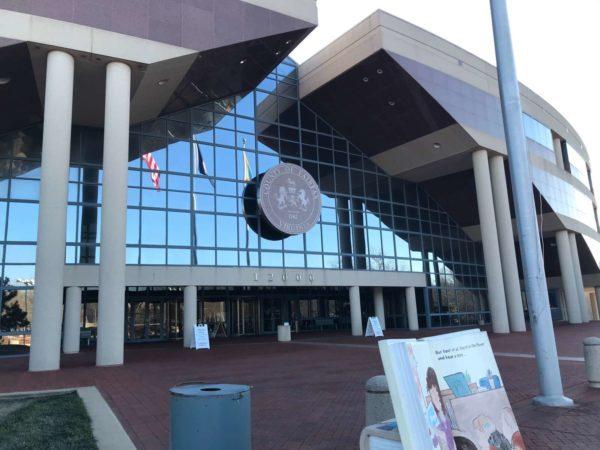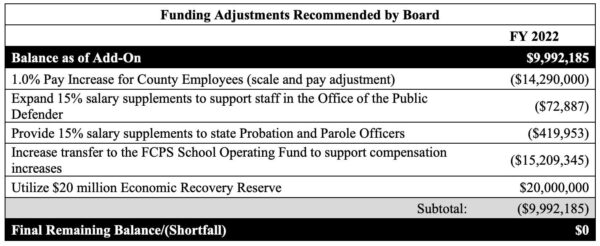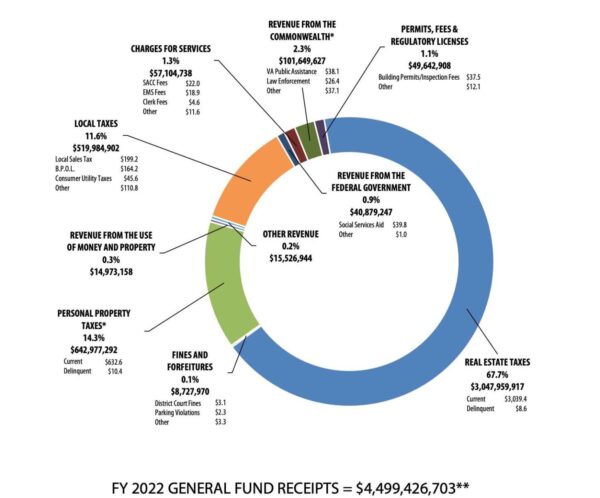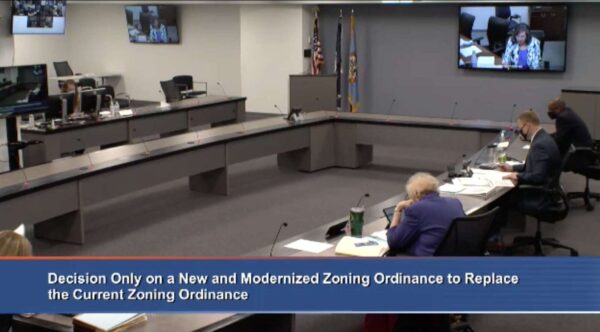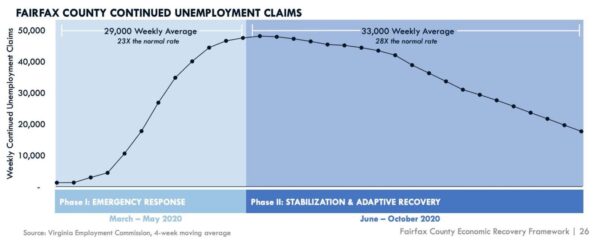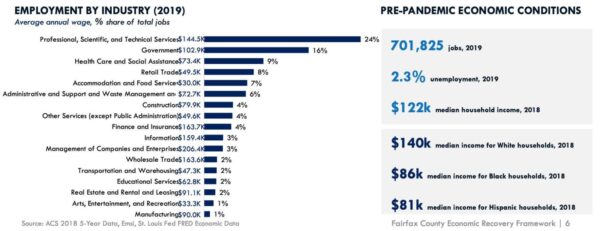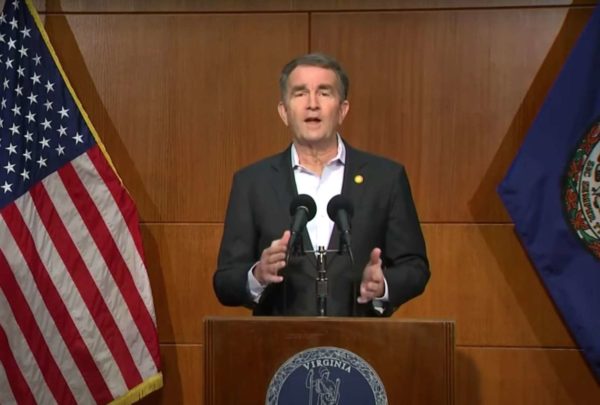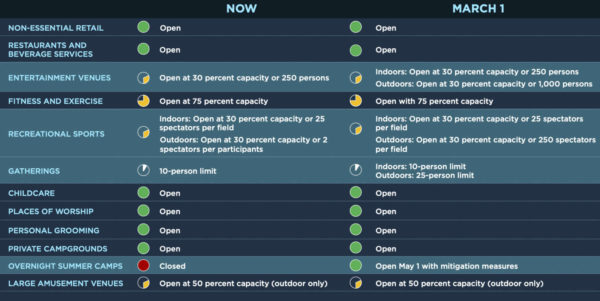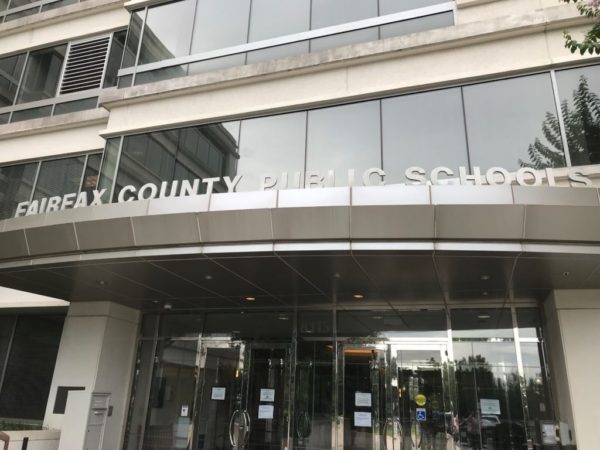Parents who have spent the last year calling for a five-day return to school for Fairfax County Public Schools students are circulating petitions to remove three Fairfax County School Board members.
They are Springfield District representative Laura Jane Cohen, Dranesville District representative Elaine Tholen, and At-Large Member Abrar Omeish.
“Our petitions are all about the board ignoring science, dismissing the wishes of parents to have kids in school, and putting politics (unions) before our children,” the Open FCPS Coalition group told Reston Now. “We have people of all walks of life — young and old, with kids and without kids signing. People were afraid to sign at first because they didn’t want to get involved. But as more time passed, and people got disappointed about the school board lying to us, they started signing.”
They admitted that the campaign faces long odds. According to Ballotpedia, Virginia has seen just one successful recall campaign in at least the past decade, with the majority of efforts — including one against former Mason District School Board representative Sandy Evans — failing to reach a circuit court.
This parent coalition has been around since November and started distributing petition templates to other counties around that time. But the momentum did not pick up until mid-February, members said.
“December and January, people still weren’t getting out much and if they were, it wasn’t to come and sign a petition,” the group said. “Many people who sign now sign because of other things that they are frustrated with, but we are just glad people are recognizing our efforts.”
The Open FCPS Coalition describes itself as a bipartisan organization.
According to the Virginia Public Access Project, donor records show that its largest gifts have come from former Republican governor candidate Pete Snyder and N2 America Inc., a conservative group that has been vocal in school reopenings. Its largest expenditure has been for signature collection services, an expense that went to a center-right door-to-door voter contact firm with ties to N2 America.
“Anyone who wants to donate is welcome to…If the Dem party wants to donate we surely will take it,” the group said. “But it seems that though many Dems have signed and silently support, some are afraid to stand up for open schools. Thankfully we have Dems in our group who are bold and brave and know that nothing about the recall is personal or about politics. It is about what is moral.”
Coalition members aimed to collect enough signatures to recall at least one school board member by the end of this school year, which concluded on Friday (June 11).
The coalition chose Cohen, Tholen and Omeish after watching school board meetings and determining only one member had a record of voting and speaking that prioritized reopening over other issues: Braddock District representative Megan McLaughlin, according to the group’s website.
So, members narrowed down their targets to the two members who were elected with the fewest number of votes — Cohen and Tholen.
“Based on this discovery, the voters in their districts would likely provide the most support for the removal effort,” according to the website.
When reached for comment, Tholen said she centers all her work and decision-making on what is best for students.
“I am busy at this point fulfilling my job as a school board member,” she said. “I am closing out this school year, celebrating our class of 2021, planning for summer programs and preparing for fall when we will welcome all students in person five days per week.”
Cohen, meanwhile, said that her “focus is, has been, and always will be ensuring our students have the best opportunity to be successful in our schools.” Read More
After getting into a new groove of providing four days of in-person learning, Fairfax County Public Schools has officially announced its plans for the fall.
The school system will offer all students five days of in-person learning in the fall and a limited virtual program for students with documented health needs.
Roughly 109,000 students and staff have returned to school buildings this school year. According to the school division, nearly 85,400 students attend in-person instruction, and more than 80% of those go at least four days a week.
Meanwhile, COVID-19 transmission rates remain less than 1% — even after schools reduced social distancing to three feet.
“We are excited to welcome all students and staff back to our buildings for the in-person experiences that we all missed this fall,” FCPS Superintendent Scott Brabrand said. “We are encouraged and hopeful that learning in the fall will look as close to normal as possible.”
Families who intend to send their kids back for five days of in-person instruction this fall will not have to do anything. Those who want to use next year’s virtual option need to apply by May 21 and include a certification of need penned by a licensed medical professional.
The virtual option is an accommodation for the pandemic and will likely not be offered beyond the 2021-22 school year, according to FCPS.
“While we are busy planning for the fall, we do recognize that some students, in very limited circumstances, may have a documented health or medical need for virtual instruction,” Brabrand said. “Today’s announcement will help ensure that we are able to continue to serve all.”
A new law requires Virginia’s school divisions to provide five days of in-person learning to families who want it this fall. No school districts are not obligated to provide a virtual option.
FCPS joins several neighboring jurisdictions in offering an in-house virtual program to students, including Arlington Public Schools, Alexandria City Public Schools, and Loudoun County Public Schools.
Unlike FCPS, which sees virtual learning as a COVID-19 measure, APS intends to one day permanently incorporate this option into its offerings.
The FCPS Virtual Program will be primarily taught by county teachers and accommodate students with special education needs and those who require English language learning services, but not all specialized programs or courses will be available.
Some courses will instead be offered through the statewide Virtual Virginia platform. FCPS officials initially proposed supporting students who need to remain online by continuing to utilize concurrent learning, where teachers provide instruction to in-person and virtual students simultaneously, but the school board decisively rejected the idea, citing teachers’ frustration with the additional workload.
School officials will decide case-by-case whether virtual students can participate in activities or athletics.
“We will see you in August,” Brabrand said.
Image via FCPS/Twitter
The Fairfax County Board of Supervisors adopted a balanced budget for fiscal year 2022 yesterday (Tuesday).
It includes some funding adjustments that the board incorporated into the proposed budget during the board’s markup session last week.
The newly adopted budget supports a 1% pay increase for county employees, a 2% raise for Fairfax County Public Schools employees, and 15% salary supplements for staff in the Office of the Public Defender and state probation and parole officers.
“While there were many constraints on this year’s budget, I am tremendously proud of what this Board was able to accomplish,” Board Chairman Jeff McKay said. “My goal was to look for balance in lowering the tax rate, with the understanding of skyrocketing property assessments, while also supporting our County employees and teachers and furthering our priorities in education, affordable housing, environmental protection, and community resources. I am pleased we were able to achieve that.”
The proposed budget from February did not include pay increases for employees, whose pay was frozen in this year’s budget. The new 1% pay increase comes after Fairfax County employees advocated for salary bumps last month.
“The 1% wage increase and one-time bonus come as a response to union members making it clear that two years of frozen pay for essential county workers was unacceptable,” SEIU Virginia 512 Fairfax Chapter President Tammie Wondong said. “We appreciate the approved change. That being said, the concessions fall short of the agreed-upon pay plan and workers are falling behind.”
The county employees’ union will now focus on its push for Fairfax County to adopt a collective bargaining ordinance. A new state law permitting localities to establish collective bargaining procedures took effect on May 1.
McKay said last week that county staff is drafting an ordinance that will be discussed at the board’s personnel committee meeting on May 25.
“Meaningful collective bargaining is the only way workers can ensure that the county keeps their promise on our pay plans so that we have the resources to provide the best services to the Fairfax community,” Wondong said.
The increase will be funded using $20 million that County Executive Bryan Hill had recommended setting aside in an “Economic Recovery Reserve.” As the county looks to rebuild, it will instead lean on the $222 million in federal relief funds it expects to receive from the American Rescue Plan Act.
“The redirection of this reserve does not exacerbate budgetary challenges in FY 2023,” the final budget document reads. “With this reserve, funding just shy of $30 million is available to be utilized for employee pay in FY 2022.”
Here are some other highlights:
As proposed in February, the real estate tax rate will decrease from $1.15 per $100 of assessed value to $1.14 per $100 of assessed value. Personal property tax rates and stormwater fees will remain the same, at $4.57 per $100 of assessed value and $0.0325 per $100 of assessed value, respectively.
As considered during the budget markup last week, the refuse disposal fee will decrease from $68 to $66 per ton, but the refuse collection fee will increase from $370 to $400 per household. The rate was reduced from $385 last year because of a reduction in yard waste collection services during the pandemic.
Funding for county government operations and contributions to Metro and Fairfax County Public Schools, or general fund disbursements, totals $4.53 billion. That marks a slight increase from the advertised $4.48 million, and an increase of $55.40 million over the current fiscal year’s disbursements.
More than half of those disbursements (52.6%, or $2.38 billion) support Fairfax County Public Schools. This includes $2.17 billion for operations, $197.12 million for debt service and $13.10 million for school construction.
Fairfax County will create 109 additional positions in FY 2022 to staff new facilities, such as the South County Police Station, a new 61,000-square-foot police station and animal shelter, and the Scotts Run Fire Station. Positions are also being added for the county’s opioid task force and Diversion First initiative.
Fairfax County Commonwealth’s Attorney Steve Descano says the budget marks an important first step toward solving Fairfax’s “longstanding justice crisis,” adding that the 15 new positions his office has been allocated will enable prosecutors to take on more cases.
“As the budget takes effect in July and we fill those, we will be able to expand our caseload to encompass all cases other than minor traffic infractions,” the Commonwealth Attorney’s office said. “We are already scaling up our caseload now and are prioritizing cases that contain an indication of violence between now and July.”
Descano says his office will complement its expanded case load with a “growing use of diversion and alternative sentencing to ensure we are keeping the community safe in a manner that accords with our values.”
Additional staffing alone won’t solve the problem, however. Descano says a multi-year investment is needed to address the “chronic shortcomings that plagued our system,” including a culture of producing as many convictions as quickly and cheaply as possible.
Charts via Fairfax County
(Updated at 4 p.m.) Starting July 1, adults 21 and older in Virginia can legally possess up to one ounce of marijuana.
Ahead of that date, local police departments say they are preparing their officers, while advocates say the bill needs serious retooling to keep kids out of the juvenile justice system and help reverse the harm done to Black and brown communities after decades of unequal enforcement.
“We still have time to fix many of these things,” Chelsea Higgs Wise, executive director of the racial justice and cannabis advocacy group Marijuana Justice, said. “Between now and then, we have elections. We have to talk to people about how they’re going to take this legalization forward while centering equity. This is not over.”
The Virginia General Assembly passed a law earlier this month accelerating the legalization of weed from July 2024 to this coming summer. The law will be reenacted in 2024, when recreational, commercial sales are legalized.
Through June 30, the possession of less than one ounce of cannabis will remain “decriminalized” — that is, it is penalized with a fine, but the incident does not show up on a person’s criminal record.
The new law legalizing cannibis essentially permits those 21 and older to use marijuana inside their homes, and possibly in their backyards; grow up to four plants; and possess up to one ounce of cannabis. The plant must be in a manufacturer’s container for someone to drive with it in the car legally.
Giving cannabis to someone underage is considered a felony, while students younger than 21 who are found in possession of the plant on school grounds would be charged with a misdemeanor. A clause requires court-ordered drug treatment services for individuals 20 and under found with the plant.
People in jail for marijuana-related crimes will remain there, Virginia Mercury reports.
Here are the top areas of interest and concern for police officers, people in the criminal justice system and advocates.
Marijuana-related arrests
Although marijuana-related arrests have been trending down recently, Falls Church City Police Chief Mary Gavin says that one potential consequence of marijuana legalization is more people driving while stoned.
“There are going to be obviously growing pains,” Gavin said. “My biggest concern, in terms of public safety, is the possible increase of driving under the influence.”
According to data provided to Tysons Reporter by the police departments, cannabis arrests appear to be trending down slightly in both Fairfax County and Falls Church City. A chart supplied by Fairfax County Police Department shows arrest rates peaking in 2018 before dropping off dramatically in 2020.
The Falls Church City Police Department reported a similar pattern. It made 61 and 63 arrests in 2018 and 2019, respectively, followed by 17 arrests in 2020 and none so far this year.
Herndon Police Department spokesperson Lisa Herndon said the town had about 125 marijuana-related arrests from Jan. 1, 2018 to Dec. 13, 2020.
Gavin attributed the recent drop-off in arrests to a combination of the COVID-19 pandemic and a policy change introduced by Fairfax County Commonwealth’s Attorney Steve Descano, who ceased prosecuting simple marijuana possession cases against adults when he took office on Jan. 2, 2020.
Descano told Tysons Reporter, Reston Now’s affiliate site, that he stopped prosecuting marijuana cases because it would be the right approach for community safety and racial equity. His office estimates that more than 1,000 cases have since been dismissed.
“While the opposition to this decision was intense at the time — so much so that we planned to create a bail fund in case our attorneys were held in contempt of court and jailed — I am pleased that other jurisdictions followed suit and marijuana has now been legalized across the Commonwealth,” Descano said. Read More

Former Baltimore Police Commissioner Kevin Davis will be the new Fairfax County chief of police, effective May 3.
After emerging from a closed session, the Board of Supervisors voted unanimously this afternoon (Friday) to appoint Davis to lead the Fairfax County Police Department. He will succeed Deputy County Executive for Public Safety Dave Rohrer, who has been serving as an interim chief since former Chief Edwin C. Roessler retired in February.
“This is a humbling moment for me,” Davis said on a video call with the supervisors. “I will take it very seriously and I promise not to let you down.”
The decision came after a firm hired by the county conducted a nationwide search that involved more than 275 community meetings and calls, more than 450 emails sent to stakeholders, and a survey that received more than 3,000 responses, according to the county.
The Board of Supervisors “strongly weighed” the survey results in the final hiring decision, the county said.
“We are delighted to have you on board,” Board of Supervisors Chairman Jeffrey McKay said. “We look forward to working with you on behalf of our community.”
Speaking to FCPD officers, Davis said, “You guys are a great agency. I want to say that loudly and clearly.”
“Is there room for improvement? Of course. Are you up to the task? Of course. Is change sometimes hard or difficult? Absolutely,” he said. “We have to seize this moment and continue to get better.”
Davis said earning trust starts with establishing legitimacy and paying attention to communities of color and people who are vulnerable and underserved.
“We have to meet you where you are, be better listeners, be less defensive and quite frankly, see you,” he said.
On accountability, Davis said he will “call balls and strikes.” And as for reform, he told police officers that the county has already embarked on a number of common-sense reforms and encouraged them to embrace this process.
“Reform is what we do for police officers, not to them,” he said. “It makes you better, it earns you better relationships with the community.”
In a statement released shortly after, McKay said Davis is recognized across the region as a leader in police reform, has a strong reputation, and is well-respected in the communities in which he has served.
“As this nation looks to transform policing to make the community safer for everyone, we have the opportunity for a fresh perspective to further our work on police reform in Fairfax County,” McKay said. “After thorough interviews, the entire Board is confident that Kevin Davis will continue Fairfax’s work on police reform, build on the deep community involvement and relationships with stakeholders, and improve morale within the police department.”
According to the county, Davis served as the City of Baltimore’s police commissioner from 2015 to 2018. He had previously served as chief of police of Anne Arundel County in Maryland from 2013 to 2014, and as assistant chief of the Prince George’s County Police Department from 1992 to 2013. Most recently, he has worked as director of consulting services for GardaWorld.
Davis will receive an annual salary of $215,000.
Photo via Fairfax County Government
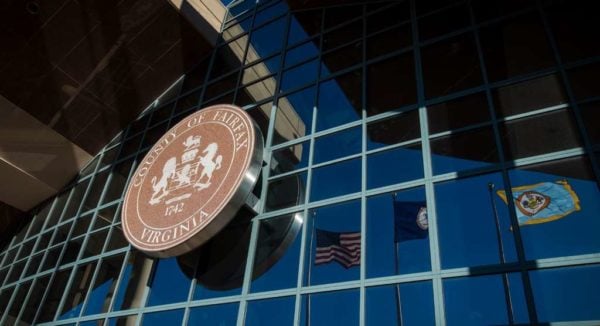
With tax season in full swing and Fairfax County plugging away at its latest budget proposal, you may wonder where exactly your tax dollars go.
Fairfax County is hammering out the details of its spending for the 2022 fiscal year, which is expected to gross more than $8.5 billion. But your tax dollars go to a smaller piece of the pie that encompasses funding for county government operations and contributions to Metro and Fairfax County Public Schools.
Totaling $4.48 billion, the general fund disbursements money comes from taxes — primarily real estate and personal property taxes, but also taxes on hotels and retail sales — as well as fees for licenses and permits. About $1.6 billion of this bucket sustains the operations of all county departments.
Real estate taxes paid by individuals and businesses contribute about $3 billion (or 68%) of the money needed to support county departments, schools, Metro, and debt services. In fact, residents’ property taxes make up about 74% of the county’s real estate tax income. The rest comes from commercial properties, such as apartments, offices, retail spaces, and hotels.
While homeowners could see their real estate tax rate lowered by one cent to $1.14 per $100 of assessed value in the upcoming budget, they will likely still see their bill increase due to rising property values. The one-cent reduction, however, will bring in $27 million less than if the current rate remained in place.
The county, meanwhile, is contending with falling commercial property values for its income from non-residential real estate taxes, a nationwide phenomenon.
But where does this tax revenue go?
After schools, which receive slightly more than half of the general fund disbursements, the county’s next two largest allocations go to public safety, including police and fire, and health and welfare, including family and neighborhood services.
Within those areas, much of the recurring spending is tied to personnel, both existing staff and requests for additional hires. The county government says an additional 109 positions are needed to staff new facilities and continue initiatives previously funded by grants and stimulus funding.
County Executive Bryan Hill’s proposed FY 2022 budget devotes $11.91 million to fund 46 positions to continue implementing the police department’s body-worn camera program and to staff the South County Police Station, a new 61,000-square-foot police station and animal shelter, and the Scotts Run Fire Station.
There is also additional funding to support the Fairfax County Office of the Commonwealth’s Attorney, which Commonwealth’s Attorney Steve Descano said last year is in a state of crisis and needs more staff, especially to handle the body-worn camera program.
The proposed budget adds seven positions to the county’s opioid task force and five positions for the Diversion First initiative.
Police and fire are the biggest drivers of the public safety budget, each accounting for around 41% of expenses, or $219 and $218 million, respectively. Overall, public safety accounts for 33% of the total general fund direct expenditures of $1.6 billion. Fairfax County lands in the middle of Virginia localities for how much it spends per person on public safety ($671 per person). Read More
The Fairfax County Board of Supervisors voted yesterday (Tuesday) to approve changes to the county’s zoning ordinance intended to make the codes easier to navigate and understand.
The 7-3 vote — with Supervisors Walter Alcorn, Daniel Storck, and Pat Herrity dissenting — serves as the culmination of a four-year Zoning Ordinance Modernization Project, or zMOD, that began in 2017 to update zoning laws codified in 1978.
Although the updates to the document were sweeping in scope, three proposed changes drew a great deal of public attention and comment. These included proposals to loosen restrictions on accessory living units and home-based businesses and revise size and height regulations for flags and flag poles.
“There are…very few issues receiving much attention,” Dranesville District Supervisor John Foust said. “I believe that demonstrates that, given everything that we’ve done, it was a fair and transparent process.”
Storck, who represents the Mount Vernon District, said he supports many aspects of the 614-page draft, but a few areas surrounding the accessory living units and the home-based businesses, including the permit process and enforcement, give him pause.
He worries that some of the proposed changes to require only administrative permits could lead to a lack of engagement and that enforcement, which he calls “the bread and butter of public confidence,” is not going to be swift or strong enough to stop zoning violations.
Approved changes to the regulations for accessory living units include allowing interior units with an administrative permit and removing the requirement that only those 55 and older or disabled people can live in them. However, the owner must live in the main home, can only operate one ALU in which up to two people can reside, and must provide a parking spot.
To operate a home-based business, people will need to get special exception permits to have customers visit between 8 a.m. and 9 p.m., unless they provide instruction to fewer than eight students a day and up to four at a time.
Acceptable businesses include retail — as long as sales and delivery occur online or offsite — as well as exercise classes, repair services for small household items, hair salons, and clothing tailors. People can also operate an office or as a music, photography, or art studio out of their home.
Residents can have up to three flags, and flag poles can be up to 25 feet tall when in front of a single-family home or up to 60 feet tall on other lots. Property owners can apply for a special permit to extend the height of a pole.
The board opted not to adopt any regulations limiting the size of flags.
In voting for the final draft of the plan, Providence District Supervisor Dalia Palchik said the document represents a compromise that goes “further than some would like to go, but not as far as others would like.”
The supervisors highlighted the Herculean effort that went into overhauling codes for a county as large as Fairfax and taking into account community input. Foust said that the most recent draft, which was subject to a public hearing on March 9, “includes revisions that significantly improve the initial package that we considered.”
Board of Supervisors Vice Chair Penelope Gross said that home-based businesses and accessory living units are both “already here,” so the changes help clarify what is allowed and set guardrails to preserve neighborhoods and allow people to work from home.
“I know there’s a lot of speculation about what will happen. Speculation is usually just that: speculation,” she said. “It sometimes is fear.”
Palchik said she does not discount the people who expressed legitimate concerns, but she argued that many of those have been addressed during the zMOD process. She aargued that many of the changes are similar to, if not “much more modest” than policies that are already in place elsewhere in the D.C. area, including in Montgomery County, D.C., Arlington, Loudoun County, and the City of Alexandria.
“While there are many changes to the zoning ordinance, I do believe it’s critical in seeing that our housing market is under pressure and costs of living continue to rise, especially for those who struggle to live here,” she said. “While accessory living units do not fix all of these problems, the added flexibility for our most vulnerable residents and additional options for those who want to remain in their homes can be part of the solution.”
Photo via Fairfax County
A consultant is recommending a dozen ways Fairfax County can uplift people whose livelihoods have been harmed by the pandemic in the short-term and promote long-term economic resilience.
Specific short-term measures include launching “Buy Local” and “Made in Fairfax” campaigns, focusing on women- and minority-owned businesses, and finding ways to reduce rent or other costs for struggling small businesses.
Other recommendations target those hit hardest — including people without high school degrees, women with children, and people of color — with services like career centers, workforce training programs, and affordable childcare.
“A lot of these things have ongoing aspects, but tying them together and focusing on economic recovery is really going to be an effective approach,” Dranesville District Supervisor John Foust said.
County staff presented plans for implementing the consultant’s recommendations and assisting small businesses during the Fairfax County Board of Supervisors economic initiatives committee meeting on Tuesday (March 16).
Fairfax County has up to $15 million in reserves to support economic recovery efforts and could also use some of the anticipated $222.56 million in federal funds coming from the American Rescue Plan, according to Foust, who chairs the committee.
Hunter Mill District Supervisor Walter Alcorn called the staff proposal “fantastic” but added that transportation — which did not figure into staff planning — should play a role in the county’s recovery efforts.
“Since we’re doing something new, I would just recommend putting more structure into collaboration across agencies,” Providence Supervisor Dalia Palchik said.
Fairfax County hired the consultant HR&A last summer to analyze how the COVID-19 pandemic has affected its economy and what the county government could do to expedite a more just recovery. More than 65 organizations and small businesses participated in the study, providing input on perceived barriers to and strategies for economic recovery.
According to the consultant’s report, before COVID-19, flourishing technology and government sectors contributed to a decade of strong economic growth for Fairfax County. The total number of jobs grew by 9% annually, and employment had reached its lowest level since the Great Recession.
In 2018, the county had the third-highest median household income in the D.C. area, but significant racial disparities lurked just below the surface: The median household income for white residents was about $140,000, exceeding that of Black households (~$86,000) and Hispanic households (~$81,000).
The pandemic reversed that job growth and exacerbated the existing disparities.
Through December 2020, Fairfax County lost an estimated 48,200 jobs, mainly in food service, hospitality, retail, and the arts. Small businesses in these three sectors will have a particularly long road to recovery, HR&A said.
The consultant also reported that job losses were most acutely felt by low-income people, people of color, and people with lower levels of formal education and training, which will make “the road to economic stability longer and more challenging.”
The job market appears to have settled down since the upheaval of the pandemic’s early days, when initial unemployment claims in Fairfax County soared to a high of 21,302 filings during the week of April 4. The Virginia Employment Commission reported today that 543 people filed new claims for the week of March 6, though the numbers ticked back up over 1,000 for multiple weeks over the winter.
HR&A outlined several ways Fairfax County can facilitate job opportunities for those suffering the most, namely, getting people who lost jobs in hard-hit industries access to jobs in industries that have weathered the pandemic better, including government and technology.
In the short-term, HR&A recommends Fairfax County employ artists to design public service announcements or put on performances. The county could also hire workers to fill temporary needs like contact-tracing, while partnering with the private sector to place people in long-term jobs.
Home to more than 8,900 technology-focused businesses, Fairfax County could pursue policies that support workforce training in health technology, digital services, and green jobs. Given its proximity to D.C., Fairfax County will continue attracting government workers, so the county should keep expanding the workforce pipeline for government and contracting work, the firm said.
The workforce will likely need skills training to acquire new qualifications, as well as equal digital access and digital literacy and adequate childcare access. This will require investing in job centers, improving certification and training programs, and making it easier to connect people with county and private services, HR&A writes.
In the long-term, the consultant recommends Fairfax County continue efforts such as easing online permitting processes and contributing to affordable housing.
Photo via Tim Mossholder on Unsplash
Dominion Energy plans to have new electric vehicle charging stations up and running in Northern Virginia this year, joining five other utility providers to create an interstate charging network that could extend from D.C. to western Texas.
The provider announced last week that it is partnering with American Electric Power, Duke Energy, Entergy Corporation, Southern Co., and the Tennessee Valley Authority to form the Electric Highway Coalition, which will provide electric vehicle charging infrastructure along major highways within their service territories.
About 18 million EVs could be on U.S. roads by 2030, according to estimates from The Edison Electric Institute. But while charging options becoming more plentiful to support everyday travel, anxiety remains among drivers about how to tackle long-distance road trips.
Dominion wants to enable electric long-distance travel for customers and its company fleet on major interstates and other well-traveled roadways, spokesperson Peggy Fox said. The charging stations will be capable of getting drivers back on the road in approximately 20-30 minutes.
“For example, in Virginia, we want to enable EV drivers to travel from the mountains to the beach or from the nation’s capital to the Virginia coast,” she said.
New stations in Fairfax County could be along I-66, I-95 and 495, and other well-traveled roads, she added. The stations will be about 100 miles apart or less, but exact locations and a concrete timeline have yet to be established.
“The partner utilities have started discussions to collaborate on site locations, site partners, design, and equipment,” Fox said.
Dominion will be coordinating with the other utility partners to provide sufficient charging capacity while using existing infrastructure and avoiding duplication, she said. The utility company plans to have a minimum of two charging stations at each location.
It has also been working with the state and locally with Fairfax County government to electrify transit. It rolled outelectric school buses in January, and in October, it debuted a self-driving shuttle that runs between Dunn Loring Metro Station and Mosaic District.
Del. Mark Keam (D-35th), who represents part of Tysons and has supported many environment-focused bills, said he welcomes Dominion’s new partnership as a “good news story,” but the General Assembly approved a number of bills in its recent legislative session to indicate the state government is serious about electrifying transit, too.
“No company is going to go do things on their own, without knowing what the state will do as a partner,” Keam said. “Us providing that level of priority allows Dominion to say, ‘OK, here’s what we will do.'”
Virginia will join a dozen other states that have adopted clean car standards requiring low- and zero-emission vehicles to be available, he said. It will also be providing a “small but still meaningful rebate” for those looking to buy one.
Keam says Dominion’s plans could work in tandem with approved bills supporting the expansion of charging infrastructure. Legislators also requested a statewide study of transit equity, and Keam successfully introduced a bill to establish a state electric school bus fund.
“We’ve really put Virginia on the map,” he said.
Still, Keam added that Dominion’s role in electrifying transit should be an ongoing discussion. It owns substantial infrastructure and supplies much of Virginia’s power, so the utility needs to be included, but state lawmakers have been unable to agree on a regulatory approach.
“We have to look at all of this with clear eyes,” he said.
Image via Dominion Energy
Inundated with messages from staff and community members on proposed changes to the 2021-22 calendar, Fairfax County School Board members directed Superintendent Scott Brabrand to redraft it.
During a work session on Tuesday (Mar. 2), the board told staff to consider ways to add flexibility through floating holidays. They said the calendar should take into account legal considerations, instruction, student wellness and pay for support staff, as well as survey preferences, absenteeism data, transparency and equity.
The school board will vote on a final calendar on Mar. 18.
FCPS announced last June that the school board will consider two ways to add in four religious holidays: Rosh Hashanah (Sept. 7, 2021), Yom Kippur (Sept. 16, 2021), Diwali (Nov. 4, 2021), and Eid al Fitr (May 3, 2022).
FCPS drafted a third proposal without those holidays in February, as some board members expressed reservations about the potential disruptions they would create.
“Support staff have been very vocal in terms of what the impact on their work will be,” School Board Chair Ricardy Anderson, who represents the Mason District, said on Tuesday. “I’m very mindful of what this means for our families who rely on schools for breakfast and lunch. We also know that we’re coming out of the pandemic, and we have had a lot of impact in terms of continuity of learning.”
Anderson reported receiving 269 messages from support staff, estimating at least 100 more. Member-at-large Karen Keys-Gamarra also said she received more than 700 written responses on the calendar.
Meanwhile, 286 students have signed a petition, and 76 clergy and faith organizations have signed a letter initiated by the Jewish Community Relations Council of Greater Washington (JCRC) urging the board to add the holidays.
Responding to the news that FCPS would be developing a new calendar, the Pozez Jewish Community Center of Northern Virginia said in a statement that it was heartened to see the board reject the calendar that did not include the new holidays.
“We are optimistic that the next option proposed will be one that is forward-thinking — acknowledging and respecting the cultural and religious diversity of the staff and students of faith in the county, as well as the community at large,” Pozez JCC Executive Director Jeff Dannick and President Susan Kristol said.
Member organizations of a Religious Observances Task Force, which FCPS formed to advise the school system on supporting religious minorities, had “strenuously” objected to the third calendar draft, saying its proposal lacked transparency.
“Given where the community has been at, where the process is so far, what data has revealed, it goes without saying that we need to give this a deliberate look,” member-at-large Abrar Omeish said.
During the work session, FCPS staff presented data from the past five years indicating that the number of absent students and staff rises on days of religious or cultural significance that are not observed in the calendar. But some board members said it is not high enough to provide secular justification for closing schools.
“Such data is a flawed indicator in this situation. It is well-known that public school students and employees very often feel forced to attend work and classes on even their most sacred holidays, for fear of being penalized or academically disadvantaged,” the Religious Observances Task Force argued in its February letter.
The school system has not “done a good job honoring religious holidays for students and employees,” Braddock District Representative Megan McLaughlin said. She told Brabrand that he and his team need to do better, and the board needs formal language to would hold him accountable.
Brabrand said FCPS can “do a better job” communicating what the division expects of children and staff on days of religious and cultural significance.
On top of concerns about pay, meals, and special education services, the proposed changes also carry legal ramifications. Schools can’t close for religious reasons unless it can be justified for secular reasons, such as absenteeism being too high for them to operate.
School board members suggested adding flexibility and protections without closing schools, such as “blackout days” — when students who choose to be absent would not be penalized — and “floating holidays” allowing staff to cash in a paid day off at any time. Some said the unenforceable guidelines for homework and test guidance around holy days should be turned into regulations.
Members also spelled out multiple areas where the calendar development process broke down, including the treatment of the Religious Observances Task Force.
For instance, the task force’s work was only included in a year-end ombudsman report, rather than being presented to the board on its own, which Mount Vernon District Representative Karen Corbett-Sanders says resulted in the findings becoming lost in the frenzy of Return to School planning.
The task force and other participants in the calendar development process had certain expectations for the calendar because of their advocacy, Hunter Mill District Representative Melanie K. Meren said.
Prince William and Arlington counties recently approved calendars with school closures on Eid, Diwali, Rosh Hashanah and Yom Kippur. Loudoun County approved a calendar with closures on Eid, Diwali and Yom Kippur.
Photo via Sandeep Kr Yadav on Unsplash
Virginia Gov. Ralph Northam is easing some of the public health restrictions prompted by the COVID-19 pandemic, including the 10 p.m. curfew on alcohol sales.
Effective Mar. 1, Virginians will be able to buy and drink alcohol at restaurants, food courts, breweries, distilleries, and wineries until they are required to close at midnight.
The changes to the current executive order come amid declining rates of hospitalizations and infections and rising vaccination rates in the Commonwealth, Northam said during a press conference this morning (Wednesday).
Northam is also easing restrictions on outdoor entertainment and social gatherings, where evidence shows the risk of airborne transmission of COVID-19 is lower.
“Thanks to the hard work and sacrifice of all Virginians, hospitalization and positivity rates across the Commonwealth are the lowest they have been in nearly three months,” Northam said in the press release. “As key health metrics show encouraging trends and we continue to ramp up our vaccination efforts, we can begin to gradually resume certain recreational activities and further reopen sectors of our economy.”
He attributed the rise in cases over the winter to cold weather and the holidays.
The state’s Safer at Home strategy will remain in place, along with its accompanying requirements for physical distancing, mask-wearing, gathering limits and business capacity restrictions.
“Even as we take steps to safely ease public health guidelines, we must all remain vigilant so we can maintain our progress — the more we stay home, mask up, and practice social distancing, the more lives we will save from this dangerous virus,” he said.
The current modified Stay at Home order will expire on Sunday (Feb. 28).
The full press release from the governor’s office is below.
Gov. Ralph Northam today announced that as COVID-19 hospitalizations and infection rates continue to decline and vaccinations rise in Virginia, certain outdoor sports and entertainment venues may begin to operate at increased capacity starting Monday, March 1. He amended Executive Order Seventy-Two with the next steps of the “Forward Virginia” plan to safely and gradually ease public health restrictions while mitigating the spread of the virus.
“Thanks to the hard work and sacrifice of all Virginians, hospitalization and positivity rates across the Commonwealth are the lowest they have been in nearly three months,” said Governor Northam. “As key health metrics show encouraging trends and we continue to ramp up our vaccination efforts, we can begin to gradually resume certain recreational activities and further reopen sectors of our economy. Even as we take steps to safely ease public health guidelines, we must all remain vigilant so we can maintain our progress-the more we stay home, mask up, and practice social distancing, the more lives we will save from this dangerous virus.”
The Commonwealth will maintain a Safer at Home strategy with continued strict health and safety protocols including physical distancing, mask-wearing requirements, gathering limits, and business capacity restrictions. The current modified Stay at Home order will expire on February 28, 2021.
Governor Northam is beginning to ease public health restrictions by taking steps to increase capacity limits in outdoor settings, where evidence shows the risk of airborne transmission of COVID-19 is lower. The key changes in the Third Amended Executive Order Seventy-Two include:
- Social gatherings: The maximum number of individuals permitted in a social gathering will increase from 10 to 25 people for outdoor settings, while remaining at 10 persons for indoor settings.
- Entertainment venues: Outdoor entertainment and public amusement venues will be able to operate with up to 1,000 individuals or at 30 percent capacity, whichever is lower. If current trends continue, these venues may be able to operate at 30 percent capacity with no cap on the number of people permitted to attend starting in April. Indoor entertainment and public amusement venues must continue to operate at 30 percent capacity with a cap of 250 people. All entertainment venues were previously limited to a maximum of 250 individuals.
- Dining establishments: The on-site sale, consumption, and possession of alcohol will be permitted until midnight, extended from 10:00 p.m. All restaurants, dining establishments, food courts, breweries, microbreweries, distilleries, wineries, and tasting rooms still must be closed between midnight and 5:00 a.m.
- Overnight summer camps: As of May 1, overnight summer camps will be able to open with strict mitigation measures in place. Registration can begin now.
The new guidelines will be effective for at least one month and mitigation measures may be eased further if key health metrics continue to improve. Current guidelines for retail businesses, fitness and exercise, large amusement venues, and personal grooming services will remain in place. Individuals are strongly encouraged to continue teleworking if possible.
The full text of Third Amended Executive Order Seventy-Two and Order of Public Health Emergency Nine is available here. Updated guidelines for specific sectors can be found here.
Last week, Governor Northam amended Executive Order Seventy-Two to increase the number of spectators permitted at outdoor youth sporting events to 250.
Visit virginia.gov/coronavirus/forwardvirginia for more information and answers to frequently asked questions.
Image via Virginia Public Media/YouTube
On Friday, Girl Scouts troops will start selling cookies in-person at least eight locations between Herndon and Reston.
For those looking to stay home, Girl Scouts Nation’s Capital is also offering online cookie sales, which will be delivered through the Girl Scouts Nation’s Capital chapter. Online sales began on Monday.
Here are the locations for Reston and Herndon, according to the Girl Scouts’ cookie finder:
Reston
- Ledo Pizza (2254 Hunter’s Woods Plaza)
- Starbucks (11170 South Lakes Drive)
- Dunkin’ Donuts (2280 Hunter’s Woods Plaza)
- Flippin’ Pizza (11130 South Lakes Drive)
- CVS (11680 Plaza America Drive)
- Starbucks (1857 Fountain Drive)
Herndon
- Food Lion (3059 Centreville Road)
- Lucia’s Italian Ristorante (2531 John Milton Drive)
Most of the booths will be out on weekends, with some also selling cookies on Fridays. The cookie finder lists dates next to all locations.
All cookie sales end March 14.
“This year we had a decrease [in in-person booths], but of course, Girl Scouts have found a way,” said Tygerian Burke, the marketing and communications manager for Girl Scouts Nation’s Capital.
Buying cookies online works like this:
- Customers can type their zip code into the cookie finder and find local troops selling cookies virtually. Each time the page loads, it will feature a different virtual booth.
- When customers click the link corresponding to the troop of their choice, the link will take them to a page with a description of what the sales will go toward and directions for buying the cookies.
- The cookies can be shipped to the customer’s house or to someone else as a donation.
The Girl Scouts are also having cookies delivered via GrubHub, a promotion that started in the D.C. area on Thursday, Burke said. Drivers can deliver cookies to homes within a 25-minute radius of where a scout or troop is located, which in D.C. traffic, will mean varying distances, she added.
She advised checking social media for Facebook Live promotions of GrubHub deliveries throughout the month-and-a-half of sales.
Burke said some troops within the council are setting up drive-through locations as well as signs with QR codes linking to their personalized virtual booth pages.
Girl Scouts are selling Thin Mints, Samoas, Trefoils, Do-si-dos and Tagalongs — as well as a new cookie called Lemon-Ups — for $5 a box. Two specialty cookies, S’mores and Toffee-tastics, go for $6 a box.
Image via Girl Scouts Nation’s Capital

Vaping has reversed years of incremental progress in Fairfax County Public Schools in the number of students who report being drug-free, according to a report from the school system.
“The slow improvement FCPS had shown over the last several years on the drug-free youth metric ended during SY 2019-20 due to increased numbers of students who reported vaping,” the report said.
Over the last couple of years, vaping has emerged as the drug of choice among students in schools across the United States. Experts and school leaders have labeled it an “epidemic,” and studies have found that it is easy to access, targeted toward teens, and highly addictive.
In FCPS, one-third of middle and high school students reported alcohol and drug usage for the 2019-20 school year. The drug-free metric FCPS uses has not moved too much in recent years, but the uptick in vaping led to a “dramatic dip” for the 2019-20 school year, when 11% of students reported that they vaped, but did not use other drugs or drink alcohol.
The rapid downward trend due to vaping “requires direct and swift action to counteract, especially given the negative health impacts that have been associated with vaping,” the report said. It concluded that more funding may be needed to address the root causes of vaping.
FCPS included vaping in its drug-free metric for the first time for the 2018-19 reporting year. At the time, the report said, vaping did not have much of an impact — students who reported vaping also reported drinking or using other drugs.
Last year, the 11% of students who vape moved the needle 2 percentage points. When vaping is added in, the percentage of students who are drug-free drops from 79% to about 77%.
During the 2020 school year, 11.2% of students reported vaping while not using alcohol or other drugs. Broken down by grade level, 9% of eighth-graders, slightly more than 12% of sophomores and 12.5% of seniors reported vaping only.
Vaping appears to have also led to an increase in drug-related suspensions. Through March 2020, the number of students with suspensions for drug and alcohol offenses was 448, an increase of 6 percentage points when compared to the 2018-19 school year — 424 offenses through March 2019.
The report found that Asian and Black students were more likely to be alcohol and drug-free than Hispanic or white students.
In its report, FCPS concluded that its current interventions may not be enough to lessen vaping and other kinds of drug and alcohol use among students overall. The report said it is unclear whether any of FCPS’s traditional interventions would have specifically impacted vaping rates.
For example, substance abuse specialists were “likely managing students with more serious drug abuse issues,” the report said. Further, the “enhanced access to middle school health lessons would likely have had only an indirect or low-level impact on vaping.”
Photo via Sharon McCutcheon on Unsplash
A former Oakton High School student is seeking a new trial in her lawsuit against the Fairfax County School Board involving a sexual assault that occurred on a school band trip in 2017.
Attorneys representing the plaintiff, known as Jane Doe, and the school board delivered oral arguments to the Court of Appeals for the Fourth Circuit remotely on Monday (Jan. 25).
According to Public Justice, the nonprofit representing the plaintiff and her family, Jane Doe — then a junior — and another bandmate — then a senior — were sitting next to each other on a bus when he touched her without her consent.
Filed in 2018, the nonprofit’s original complaint alleged that administrators and employees failed to take meaningful and appropriate action. According to the complaint, administrators threatened to discipline her and discouraged her from reporting the assault to police or taking legal action.
In August 2019, a jury with the U.S. District Court in Alexandria found that Jane Doe was sexually harassed and that the experience negatively impacted her education. But the jury did not find the Fairfax County School Board could be held liable for the deprivation of her education as a result of her assault.
The jury determined that the school board did not have “actual knowledge” about the assault, though one juror later said there was confusion over the term’s definition. As a result, the jury did not discuss the final question in the case, which asked whether the school board acted with deliberate indifference toward Doe’s complaint.
FCPS’s liability, which appears to hinge on the extent to which school officials knew an assault had taken place and whether they took sufficient action to address the plaintiff’s concerns, is now being relitigated.
“There may be hard actual knowledge cases, but this isn’t one of them. This family did all they could to put the school on notice,” Public Justice attorney Alexandra Brodsky said in her argument on Monday. “This court should remand a new trial so a jury can reach, for the first time, the question of whether the school did enough.”
Stuart Raphael, the attorney for the school board, argued that the board did not have “actual knowledge” because Doe — in a conversation with Fairfax County Public Schools Director of Student Services Jennifer Hogan — did not describe her experience as sexual assault or nonconsensual. He added that Doe was “incredulous” when another administrator asked if she would press charges.
He argued that these facts, as well as inconsistencies between the stories that reached administrators, support the jury’s initial finding that the school board had no “actual knowledge” of the sexual assault.
“It cannot be that a school administrator’s failure to understand what constitutes sexual harassment is an absolute bar to liability,” Brodsky said. “That’s why this court and others have treated a failure to categorize reports of sexual harassment as evidence of a deficient response.”

Hotel rooms have suddenly become difficult to come by in Fairfax County ahead of Inauguration Day on Wednesday.
That is a welcome problem for the lodging sector of the hospitality industry, which has been in a downward spiral since the COVID-19 pandemic prompted a slew of travel restrictions and stay-at-home health guidance.
But this inauguration will be unlike any other in recent political history. The general public’s ability to attend President-elect Joe Biden and Vice President-elect Kamala Harris’s Oath of Office ceremony has been sharply curtailed due to the pandemic, but hotels are hosting another large group of guests: the National Guard.
Up to 21,000 members of the National Guard have been authorized to come to D.C. and secure the city ahead of potential attacks, after Trump supporters stormed Capitol Hill on Jan. 6. Fairfax County hotels are reportedly housing some of the 15,000 guard members already in the D.C. metropolitan area.
“We are indeed hearing anecdotally from hoteliers that there has been an uptick in reservations compared with the past 11 months, but we are unable to ascertain whether those reservations are directly related to the inauguration and/or the National Guard or people who are visiting for leisure or business travel,” Visit Fairfax President and CEO Barry Biggar said in a statement.
The pandemic and ensuing shutdowns devastated the hospitality industry across the U.S. In Virginia, COVID-19 has resulted in the loss of about 100,000 jobs, according to the American Hotel and Lodging Association.
In November, the AHLA found that 71% of its member hotels said “they won’t make it another six months without further federal assistance given current and projected travel demand.” 47% of respondents said they would be forced to close hotels.
Many hotels were forced to layoff more staff this winter, even as access to the second round of the Paycheck Protection Program has expanded to all lenders.
But the employees who remain taking the sudden surge of guests in stride, Biggar explains.
“What we do know is that our hotels have been working tirelessly, even with staff shortages and for long hours, to ensure that our guests are treated with the utmost hospitality,” he said.
Photo courtesy Sheraton Reston



